Common Printing Problems and Their Solution
Printers are important tools in both home and office settings, but they can often encounter various problems that disrupt productivity and cause frustration. Common printer problems can range from paper jams and connectivity issues to poor print quality and frequent error messages. Understanding the issues and knowing how to troubleshoot them effectively is crucial for maintaining a smooth workflow and ensuring the longevity of your printer. In this blog, we will delve into some of the most common printer problems and provide practical solutions to help you resolve them quickly and efficiently. Whether you’re dealing with a stubborn paper jam or struggling with connectivity, our guide will equip you with the knowledge you need to tackle these challenges head-on and keep your printer running smoothly.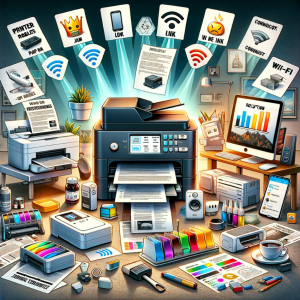
Paper Jams
One of the most common printer problems that users encounter is paper jams. This frustrating issue can bring your printing tasks to a halt and, if not addressed properly, can lead to further printer damage. Paper jams occur when paper gets stuck in the printer’s rollers or other internal parts, often due to improper loading or using paper that doesn’t match the printer’s specifications.
Step-by-Step Guide to Safely Remove Jammed Paper:
-
Turn Off the Printer:
To avoid injury or damage to the printer, always turn it off and unplug it before attempting to remove jammed paper.
-
Open the Printer:
Carefully open the printer’s access doors or panels to locate the jammed paper. Refer to your printer’s manual for specific instructions on how to access the paper path.
-
Gently Remove the Paper:
Using both hands, carefully take the jammed paper out in the direction of the paper path. Avoid tearing the paper or pulling it out forcefully, as this can leave remnants inside the printer.
-
Check for Remaining Bits:
Inspect the rollers and paper path for any last bits of paper or debris that could cause another jam.
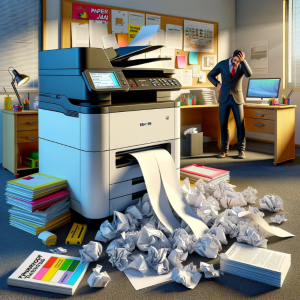
-
Close the Printer:
Once you’ve cleared the jam, close all access doors and panels securely.
-
Turn the Printer On:
Plug in and turn on the printer. Perform a test print to ensure that the paper jam has been fully resolved.
Tips to Prevent Future Paper Jams:
-
Use the Right Paper:
Always use paper that meets your printer’s specifications regarding size, weight, and type.
-
Load Paper Correctly:
Ensure that the paper is loaded properly into the tray, without any folded edges or wrinkles.
-
Avoid Overloading:
Do not exceed the maximum paper capacity of the tray, as overloading can lead to jams.
-
Regular Maintenance:
Keep your printer clean and free of dust by regularly wiping down exterior and interior with a gentle, dry cloth.
By understanding the reasons of paper jams and following these preventative measures, you can decrease the likelihood of experiencing this common printer problem and ensure smoother printing operations.
Poor Print Quality
One of the most common printer problems that users encounter is poor print quality. This issue can manifest in various forms.
-
Common Causes of Poor Print Quality:
- Faded prints, smudges, streaks, or unclear text and images.

- Low ink or toner levels, clogged or dirty print heads, incorrect paper or print settings.
- Faded prints, smudges, streaks, or unclear text and images.
-
Checking Ink or Toner Levels:
- Ensure ink or toner levels are sufficient for consistent print quality.
- Replace low cartridges or refill ink tanks as needed.
-
Cleaning Print Heads:
- Use the printer’s built-in cleaning function to remove clogs.
- For persistent issues, manually clean print heads with a soft cloth and distilled water or a cleaning solution.
-
Selecting the Right Paper and Print Settings:
- Use paper compatible with your printer.
- Adjust print settings based on the document or image type (e.g., higher resolution for detailed images).
- Ensure proper paper loading and print alignment.
-
Maintaining Print Quality:
- Regular maintenance and use of the right supplies are essential.
- Addressing common factors can significantly improve print quality and prevent frustration.
By following these guidelines, you can maintain optimal print quality and avoid common printer problems related to poor prints.
Printer Connectivity Issues
Printer connectivity issues are among the most common printer problems faced by users. These issues can arise from different sources, including Wi-Fi, Bluetooth, and USB connections. Understanding how to troubleshoot each connectivity type can save time and reduce frustration.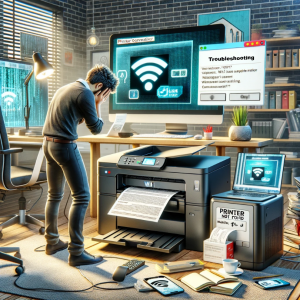
-
Wi-Fi Connectivity Issues:
Wi-Fi problems are prevalent in wireless printers. If your printer is not connecting to the Wi-Fi network, start by ensuring that the printer is within range of the router. Interference from other electronic devices can weaken the signal. Restarting both the printer and router can often resolve connection issues. Check the printer’s network settings to ensure it’s connected to the correct network, and update the printer’s firmware if necessary. If the problem persists, try reconnecting the printer to the network by re-entering the Wi-Fi password.
-
Bluetooth Connectivity Issues:
For printers using Bluetooth, ensure that the printer is properly paired with your device. Check if Bluetooth is enabled on both the printer and your device, and make sure the printer is set as a discoverable device. If pairing fails, remove the printer from the list of paired devices and try pairing it again. Keep in mind that Bluetooth connections might have a shorter range compared to Wi-Fi.
-
USB Connectivity Issues:
USB connectivity problems are usually straightforward to diagnose. Check if the USB cable is safely connected to both the printer and the computer. Try using a different USB port or a different cable to rule out hardware issues. If the printer is still not recognized, there might be a problem with the USB drivers on your computer.
-
Resetting Printer’s Network Settings:
If all else fails, resetting your printer’s network settings can often resolve connectivity issues. This can usually be done through printer’s control panel or settings menu. Be aware that this will erase all current network settings, and you will need to reconnect the printer to your network.
By following these troubleshooting procedures, you can resolve most printer connectivity issues and ensure a smooth printing experience.
Printer Driver Problems
Printer drivers are crucial software components that facilitate communication between your printer and computer. Issues with printer drivers can lead to various problems, including printing errors, incorrect prints, or inability to print.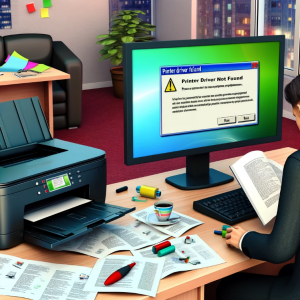
-
Common Printer Driver Issues:
Outdated or incompatible drivers, often resulting from system upgrades or new printer models.
-
Solutions for Printer Driver Problems:
- Regularly check for and install driver updates from the printer manufacturer’s official website.
- If updating does not resolve the issue, try reinstalling the printer driver by uninstalling the current driver and installing a fresh one.
- In cases where a new driver update causes problems, consider rolling back to a previous version through the Device Manager in Windows.
- For difficulty in finding the right drivers, use automated driver update tools to identify and install the correct drivers automatically.
-
Maintaining Printer Drivers:
- Keeping printer drivers up-to-date is crucial for minimizing common printer problems and ensuring smooth printing operations.
- Knowing how to reinstall or roll back drivers when necessary can help in effectively troubleshooting driver-related issues.
Slow Printing Speed
Slow printing speed is a common issue that can significantly hinder productivity, especially in busy office environments. Understanding the reasons behind slow printing speeds and knowing how to address them can help improve your printer’s performance.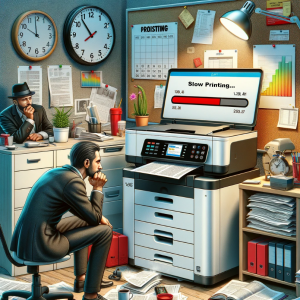
Reasons Behind Slow Printing Speeds:
-
High-resolution settings:
Higher quality settings require more data processing, slowing down print speed.
-
Duplex printing:
Printing on both sides of paper can reduce speed.
-
Network issues:
Slow network connections can delay data transmission to network printers.
-
Outdated drivers:
Old or incompatible drivers can affect printing efficiency.
Tips to Increase Print Speed:
- Lowering the resolution in printer settings can speed up printing.
- Turn off double-sided printing when not needed.
- Make sure a stable and fast network connection for network printers.
- Install the latest printer drivers for optimal performance.
How to Adjust Printer Settings for Faster Printing:
- Go to your printer’s settings or properties menu on your computer.
- Look for a setting like Draft or Fast mode to reduce print quality and speed up printing.
- Find the duplex or double-sided printing option and disable it.
- Apply the changes and save the settings for future print jobs.
By addressing these factors and adjusting your printer settings accordingly, you can significantly improve your printing speed and efficiency.
Error Messages
Dealing with printer error messages can be a daunting task, especially when they disrupt your printing tasks. Understanding these common printer problems and their solutions can help you quickly get back to smooth printing operations.
Common Printer Error Messages:
-
Paper Jam:
Indicates that paper is stuck in the printer.
-
Low Ink/Toner:
Warns that the ink or toner levels are running low and need replenishment.
-
Offline:
Suggests that the printer is not connected to the computer or network.
-
Error Code 0x6100004a:
A specific error code related to hardware or software issues in HP printers.
Resolving Specific Error Codes:
- For a Paper Jam error, carefully remove any jammed paper from printer, ensuring not to tear it. Check all possible areas where paper could be stuck, including the paper tray and output tray.
- When encountering a Low Ink/Toner message, replace the ink or toner cartridge with a new one. It’s advisable to use cartridges recommended by the printer manufacturer.
- If your printer displays Offline, check the connection between the printer and the computer or network. Ensure that the printer is turned on and connected properly. If you still face the issue, you can read our blog post on Printer Offline issue.
- For specific error codes like 0x6100004a, refer to the printer’s manual or the manufacturer’s website for detailed troubleshooting steps. These often involve resetting the printer or checking for hardware issues. If you face error in Epson Printer, read our comprehensive blog on Epson Printer Error Code 0X97.
By familiarizing yourself with common printer error messages and their solutions, you can efficiently tackle printer problems and ensure a smoother printing experience. If you face error code in Canon Printer, you can read our in-depth blog on Fix Canon b200 error MX922.
Running Out of Ink or Toner Too Quickly
One of the most common printer problems that users face is the rapid depletion of ink or toner. This issue can be both frustrating and expensive, especially if you find yourself replacing cartridges more frequently than expected. Understanding the reasons behind this and learning some tips for conserving ink or toner can help you extend the life of your cartridges and save money in the long run.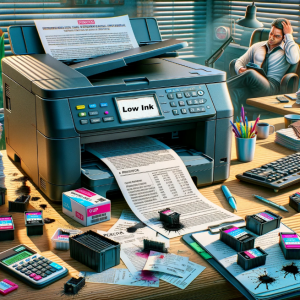
Reasons for Fast Depletion:
-
High-Resolution Printing:
Printing at high resolutions uses more ink or toner to produce detailed images.
-
Frequent Use of Color:
Color printing consumes more ink compared to black-and-white printing.
-
Type of Documents:
Documents with heavy graphics or solid fills require more ink or toner.
-
Printer Settings:
Default printer settings might not be optimized for ink or toner conservation.
Tips for Conserving Ink/Toner:
-
Use Draft Mode:
For everyday printing, switch to draft mode, which uses less ink or toner.
-
Print in Grayscale:
If color is not essential, print documents in grayscale to save color ink or toner.
-
Optimize Printer Settings:
Adjust your printer settings to use less ink or toner, such as reducing print quality for non-essential documents.
-
Regular Maintenance:
Perform regular printer maintenance, such as cleaning the print heads, to ensure efficient ink or toner usage.
Compatible vs. Original Cartridges:
-
Compatible Cartridges:
These are third-party cartridges that are often cheaper than original ones. However, they might not be as efficient in ink usage and could potentially void your printer’s warranty.
-
Original Cartridges:
Manufactured by the printer brand, these cartridges are designed primarily for your printer model and tend to provide better print quality and efficiency in ink or toner usage.
FAQs
Q1: What are some common printer problems?
A1: Common printer problems include paper jams, poor print quality, connectivity issues, driver problems, slow printing speeds, error messages, and running out of ink or toner quickly.
Q2: How can I prevent paper jams in my printer?
A2: To prevent paper jams, use the correct paper size and type, avoid overloading the paper tray, and ensure the paper is properly aligned. Regularly clean your printer to remove any debris that could cause jams.
Q3: What should I do if my print quality is poor?
A3: If you’re experiencing poor print quality, check your ink or toner levels and replace any low cartridges. Clean your print heads and align your printer. Also, ensure you’re using the correct paper type and print settings for your document.
Q4: How can I fix printer connectivity issues?
A4: For Wi-Fi connectivity issues, ensure your printer is within range of your router and restart both devices. For Bluetooth issues, check that your printer is paired correctly. For USB issues, try using a different cable or port. If network printer issues persist, check your printer’s IP address and network settings.
Q5: What should I do if I’m having driver problems with my printer?
A5: If you’re experiencing driver problems, update your printer drivers to the most recent version from the manufacturer’s website. If the issue sustains, try reinstalling the driver or rolling back to a previous version.
Q6: How can I speed up my printer’s printing speed?
A6: To increase your printer’s speed, reduce the print quality for non-essential documents, disable duplex printing, and adjust the printer settings to prioritize speed.
Q7: What does it mean if I’m getting error messages from my printer?
A7: Error messages can indicate various issues, such as paper jams, low ink levels, or connectivity problems. Refer to your printer’s manual for specific solutions to error codes.
Q8: Why is my printer using ink or toner so quickly?
A8: Fast depletion of ink or toner can be due to high-resolution printing, frequent color printing, and inefficient printer settings. Use draft mode, print in grayscale, and optimize your printer settings to conserve ink or toner.
Conclusion
Understanding the factors that contribute to the quick depletion of ink or toner and implementing strategies to conserve these resources can significantly reduce your printing costs and minimize common printer problems. Always consider the impact of using compatible vs. original cartridges on your printer’s performance and warranty.
Addressing printer problems promptly is crucial to maintain the effectiveness and longevity of your printing equipment. Whether you’re dealing with paper jams, poor print quality, connectivity issues, driver problems, slow printing speeds, error messages, or the rapid depletion of ink or toner, it’s important to take proactive steps to resolve these issues.
We encourage you to follow the solutions outlined in this blog for common printer problems. Regular maintenance, proper setup, and careful usage can prevent many of these issues from occurring in the first place. By staying informed about your printer’s needs and how to address potential problems, you can ensure a smoother, more reliable printing experience.
To know more about printer support service, visit our homepage.
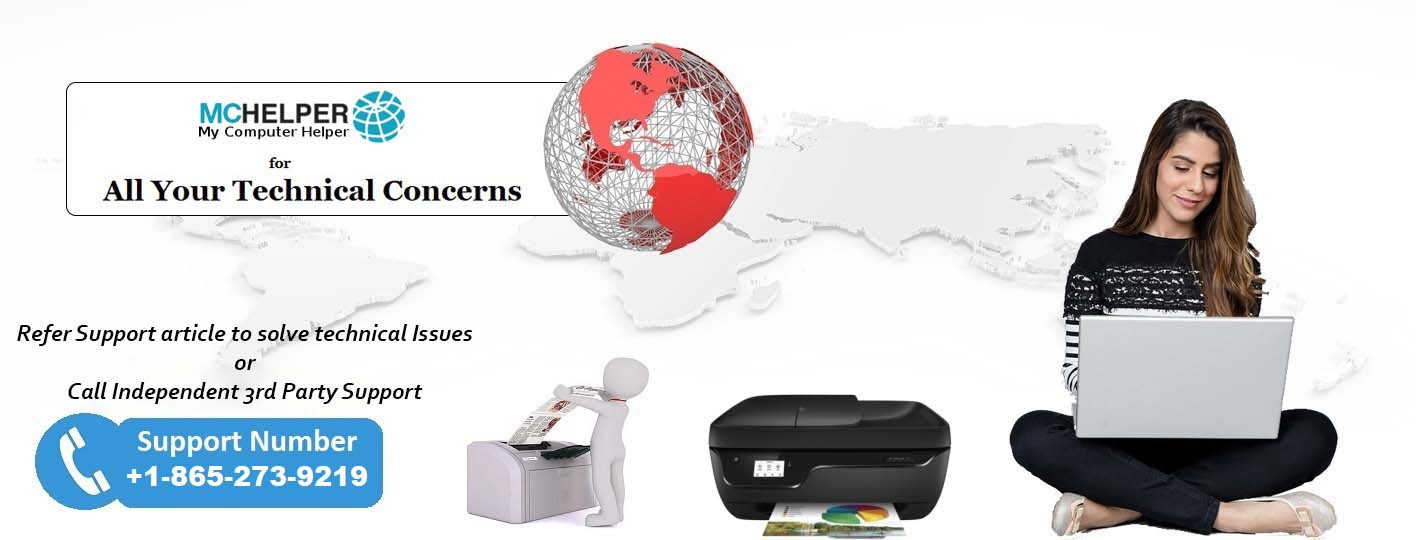
William wilson
In my daily printing tasks, I frequently face paper jams, which disrupt my workflow and productivity. I’ve been careful about selecting the right paper type and ensuring it’s properly loaded, yet these common printer problems persist. What detailed strategies can you suggest to tackle paper jams more effectively, especially considering the need for quick resolution in a busy office setting?
Support Admin
Paper jams are indeed frustrating and a common printer problem many encounter during their daily printing tasks. To combat this issue more effectively, it’s important to not only use the correct paper type but also to regularly maintain your printer’s internal mechanisms. This includes gently cleaning the paper feed rollers and checking for wear and tear that might affect their functionality. It’s also beneficial to periodically review your printer’s user manual for specific maintenance tips and troubleshooting steps related to paper jams. Additionally, adjusting printer settings to match the paper type and thickness can help prevent jams. For printers used heavily on a daily basis, consider scheduling professional maintenance a few times a year to keep everything in top condition. Implementing these strategies can significantly reduce the occurrence of paper jams in your office, improving efficiency and minimizing downtime related to common printer problems.
Richard mitchell
Lately, the print quality of my documents has been subpar, with text and images appearing faded or streaky. This is concerning, especially when producing professional documents. I’ve replaced low ink cartridges and performed basic printer maintenance, but the issue persists. Could you provide insight into enhancing print quality, utilizing advanced techniques or settings adjustments to address this common printer problem?
Support Admin
To enhance print quality and address this common printer problem, it’s essential to delve deeper into both your printer’s maintenance routines and the settings used for your documents. First, conduct a thorough print head cleaning cycle using your printer’s built-in function, as clogged print heads are a frequent cause of poor print quality. If the problem continues, manually cleaning the print heads with a soft, lint-free cloth and distilled water might be necessary. Ensure that you’re using the best paper type for your specific prints, as the wrong paper can significantly impact quality. Additionally, adjusting your printer’s settings to specifically suit the content of your documents, such as selecting ‘high resolution’ for detailed images or ‘text mode’ for crisp, clear letters, can make a remarkable difference. Regularly updating your printer’s firmware and drivers can also improve performance, as manufacturers often release updates to enhance print quality and rectify common printer problems. By taking these steps, you can achieve the high print quality necessary for professional documents.